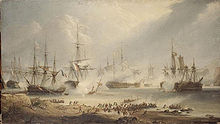
Back حملة الجزيرة الخضراء Arabic Emgann Algeciras (1801) Breton Campaña de Algeciras (1801) Spanish Bataille d'Algésiras (1801) French Campagna di Algeciras Italian
| Algeciras campaign | |||||||
|---|---|---|---|---|---|---|---|
| Part of the War of the Second Coalition | |||||||
 The battle of Algeciras, Alfred Morel-Fatio | |||||||
| |||||||
| Belligerents | |||||||
|
| |||||||
| Commanders and leaders | |||||||
|
|
| ||||||
The Algeciras campaign (sometimes known as the Battle or Battles of Algeciras) was an attempt by a French naval squadron from Toulon under Contre-Admiral Charles Linois to join a French and Spanish fleet at Cadiz during June and July 1801 during the French Revolutionary Wars prior to a planned operation against either Egypt or Portugal. To reach Cadiz, the French squadron had to pass the British naval base at Gibraltar, which housed the squadron tasked with blockading Cadiz. The British squadron was commanded by Rear-Admiral Sir James Saumarez. After a successful voyage between Toulon and Gibraltar in which a number of British vessels were captured, the squadron anchored at Algeciras, a fortified port city within sight of Gibraltar across Gibraltar Bay. On 6 July 1801, Saumarez attacked the anchored squadron, in the First Battle of Algeciras. Although severe damage was inflicted on all three French ships of the line, none could be successfully captured and the British were forced to withdraw without HMS Hannibal, which had grounded and was subsequently seized by the French.
In the aftermath of the first battle, both sides set about making urgent repairs and calling up reinforcements. On 9 July a fleet of five Spanish and one French ship of the line and several frigates arrived from Cadiz to safely escort Linois's squadron to Cadiz, and the British at Gibraltar redoubled their efforts to restore their squadron to fighting service. In the evening of 12 July the French and Spanish fleet sailed from Algeciras, and the British force followed them, catching the trailing ships in the Second Battle of Algeciras and opening fire at 11:20. A confused night action followed in which the British ship HMS Superb cut through the disorganised Franco-Spanish rearguard, followed by the rest of Saumarez's force. In the confusion one French ship was captured, a Spanish frigate sank and two huge 112-gun Spanish first rates collided and exploded, killing as many as 1,700 men. The following morning the French ship Formidable came under attack at the rear of the combined squadron, but successfully drove off pursuit and reached Cadiz safely.
Ultimately the French and Spanish fleets were successful in their aim of uniting at Cadiz, albeit after heavy losses, but they were still under blockade and in no position to realise either the Egyptian or the Portuguese plans. The two battles, "generally regarded as a single linked battle",[1] proved decisive in cementing British control of the Mediterranean Sea and condemning the French Army in Egypt to defeat, totally unsupported by reinforcements from the French Navy.
- ^ Mostert, p. 408